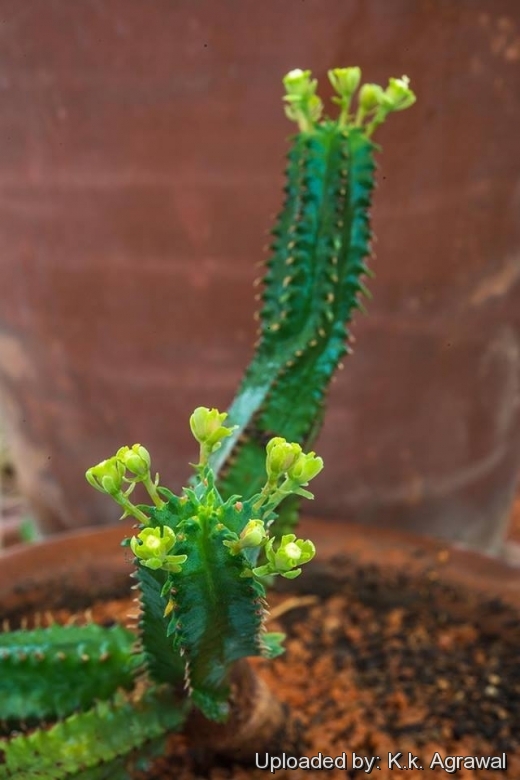




Your support is critical to our success.

A male E. tubiglans, in flower.
Origin and Habitat: Euphorbia tubiglansSN|13423]]SN|27173]] is endemic to the Little Karoo in the Western Cape and Eastern Cape of South Africa (Jansenville District near Klipplaat, Uitenhage District 3 km from Kleinpoort on the Steydtlerville road, Swellendam District, Angora, near Bonnievale, Ladismith District near Lemoenhoek and Garcia Pass, Robertson District near Robertson. Euphorbia jansenvillensisSN|27173]]SN|13423]] grows in the same area.
Habitat: This species grows under the protection of other succulents and shrubs.
Synonyms:
- Euphorbia tubiglans Marloth ex R.A.Dyer
RUSSIAN (Русский): Молочай тубигланс
Description: Euphorbia tubiglansSN|14415]]SN|27173]] is a tufted, unisexual (dioecious), spineless dwarf succulent distinguished by its thick, fleshy rootstock or caudex, which in turn produces a long taproot. The short main stem is constricted into a very narrow neck which joins the branches at the apex of the underground rootstock. Several five-sided stems arise from its tip, they begin with a thin, stem-like part, which suddenly thickens. The ribs are gently dentate. This is the typical growth habit of seed-grown plants. Plants grown from cuttings hardly resemble the typical growth form, they continue growth as elongated branches which later branch near the base but do not form a tap root. By radically shortening the cutting and planting it below surface the natural growth form can be somewhat simulated.
Derivation of specific name: The species name refers to the tubular (tubi-) nectar glands (-glans) of the cyathia.
Rootstock: The tuberous main root (rootstock or caudex) which is a continuation of the very short underground main stem, is turnip-like or stumpy carrot-like up to 8.5 cm long and 4.5 cm thick, soft when young and hardening and cracking with age.
Stems: Main stem very short constricted into a very narrow neck which joins the branches at the apex of the underground tuberous rootstock. The main stem produces a cluster of 2-5 aerial upright, columnar branches, always unbranched, less than 80 mm tall and 1.5-2 cm in diameter, but often longer in cultivation, dark blueish green in colour, with a waxy bloom, each on a stalk-like neck about 1 cm long, and with 5- to 6 longitudinal ribs. The ribs are somewhat obtuse, with very small tubercles.
Flowers (cyathia): Unisexual, male and female cyathia on separate plants. Peduncles about 2 cm long, 3 mm across, reddish, supported by 3 small bracts; glands are distant and fold inwards laterally, forming a tube (hence the specific name) and are red, contrasting with the white involucre lobes.
Fruits (capsules): 3-lobed about 3 mm across.
Similar species: The aerial parts of Euphorbia jansenvillensisSN|13423]]SN|13423]], from the same area, look similar to those of E. tubiglans but are up to 16(-30) cm long; they rebranch or segment, and the reduced underground stem produces rhizomes. The structure of the inflorescences is nearly identical to that of E. tubiglans, but the involucral glands are distant, erect, deltoid and yellowish-green. This species is similar to, if not the same as, E. tubiglans. Euphorbia pseudoglobosaSN|27173]]SN|14415]] belongs to this same growth-form. As in E. tubiglans this plant also has a fleshy main root and a short, subterranean stem from which emerge numerous spherical to fat-cylindrical stems with 5 to 6 ribs. The single, short-stalked cyathia do not have the leafy scape bract hulls as in E. jansenvillensis and E. tubiglans.
Bibliography: Major references and further lectures
1) Doreen Court “Succulent Flora of Southern Africa” CRC Press, 01/June/2000
2) White, A., Dyer, R.A. & Sloane, B.L. 1941. “The succulent Euphorbieae“, vol. 2. Abby Garden Press. Pasadena, California.
3) Urs Eggli “Illustrated Handbook of Succulent Plants: Dicotyledons” Volume 2. Springer, 2002
4) Hermann Jacobsen “A handbook of succulent plants: descriptions, synonyms, and cultural details for succulents other than Cactaceae” Volume 1 Blandford Press, 1960
5) James Cullen, Sabina G. Knees, H. Suzanne Cubey “The European Garden Flora Flowering Plants: A Manual for the Identification of Plants Cultivated in Europe, Both Out-of-Doors and Under Glass” Cambridge University Press, 11/August/2011
6) The Euphorbia Journal 2: 139 (1984)
7) Alain Campbell White, Robert Allen Dyer, Boyd L. Sloane “The succelent Euphorbisae (southern Africa)” Abbey garden press, 1941
8) “The Plantsman” New Perspectives Pub., 1992
9) Werner Rauh “The Wonderful World of Succulents: Cultivation and Description of Selected Succulent Plants Other Than Cacti” Smithsonian Institution Press, 1984
10) Sukkulente Euphorbien “Three similar species - Euphorbia jansenvillensis, nesemannii and tubiglans” http://www.euphorbia.de web 05 April 2015.
Cultivation and Propagation: Euphorbia tubiglansSN|27173]]SN|27173]] likes a sunny position. It does best in a mineral soil, good drainage is essential. Water sparingly during the summer months and keep dry in winter. It is a slow growing long lived plant and once established, it will be content in its position and with its soil for years. It can tolerate moderate shade, and a plant that has been growing in shade should be slowly hardened off before placing it in full sun as the plant will be severely scorched if moved too suddenly from shade into sun. Contrarily to Euphorbia jansenvillensisSN|13423]]SN|13423]], Euphorbia tubiglansSN|27173]]SN|27173]] has a large tap root and requires a relatively deep pot.
Propagation: The plant can be reproduced by seeds sown during spring or summer, cuttings and division of larger clumps. If you remove an offset, remember to let it dry for a week or so, letting the wound heal (cuttings planted too soon easily rot before they can grow roots). It is better to wash the cut to remove the latex.
Warning: As with all other Euphorbias, when a plant gets damaged it exudes a thick white milky sap known as latex. This latex is poisonous and may irritate skin, so pay extreme attention not to get any in your eyes or mouth.
Cultivated plants must be handled carefully.
| Your Actions | |
|---|---|
| Back to Euphorbia index | |
| Back to Euphorbiaceae index | |
 |
Back to Succulents Encyclopedia index |
Privacy stantement - Terms and conditions - How to cite - About us - Feedback - Donate



